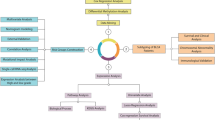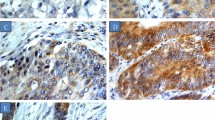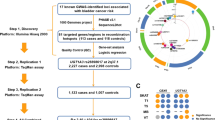Summary
Aromatic amines from cigarette smoking or occupational exposure, recognized risk factors for bladder cancer, are metabolized by N-acetyltransferases (NAT). This study examined the association of (NAT) 1 and 2 genotypes with the risk of smoking-related bladder cancer. A total of 74 pathologically confirmed bladder cancer patients and 184 controls were serially recruited from the National Taiwan University Hospital. History of cigarette smoking and other risk factors for bladder cancer was obtained through standardized questionnaire interview. Peripheral blood lymphocytes were collected from each subject and genotyped for NAT1 and NAT2 by DNA sequencing and polymerase chain reaction-restriction fragment length polymorphism methods. Allele frequency distributions of NAT1 and NAT2 were similar between cases and controls. There was a significant dose–response relationship between the risk of bladder cancer and the quantity and duration of cigarette smoking. The biological gradients were significant among subjects carrying NAT1*10 allele or NAT2 slow acetylators, but not among NAT2 rapid acetylators without NAT1*10 allele. The results are consistent with the hypothesis that NAT1 and NAT2 might modulate the susceptibility to bladder cancer associated with cigarette smoking.
Similar content being viewed by others
Article PDF
Change history
16 November 2011
This paper was modified 12 months after initial publication to switch to Creative Commons licence terms, as noted at publication
References
Augustine, A, Hebert, JR, Kabat, GC & Wynder, EL (1988). Bladder cancer in relation to cigarette smoking. Cancer Res 48: 4405–4408.
Bartsch, H, Malaveille, C, Friesen, M, Kadlubar, FF & Vineis, P (1993). Black (ari-cured) and blond (flue-cured) tobacco cancer risk IV: molecular dosimetry studies implicate aromatic amines as bladder carcinogens. Eur J Cancer 29A: 1199–1207.
Bell, DA, Taylor, JA, Butler, MA, Stephens, E, Wiest, J, Brubaker, L, Kadlubar, FF & Lucier, GW (1993). Genotype/phenotype discordance for human arylamine N-acetyltransferase (NAT2) reveals a new slow-acetylator allele common in African-Americans. Carcinogenesis 14: 1689–1692.
Bell, DA, Badawi, AF, Lang, NP, Ilett, KF, Kadlubar, FF & Hirvonen, A (1995a). Polymorphism in the N-acetyltransferase 1 (NAT1) polyadenylation signal: association of NAT1*10 allele with higher N-acetylation activity in bladder and colon tissue. Cancer Res 55: 5226–5229.
Bell, DA, Stephens, EA, Castranio, T, Umbach, DM, Watson, M, Deakin, M, Elder, J & Berkowitz, RS (1995b). Polyadenylation polymorphism in the acetyltransferase 1 gene (NAT1) increases risk of colorectal cancer. Cancer Res 55: 3537–3542.
Brockmoller, J, Cascorbi, I, Kerb, R & Roots, I (1996). Combined analysis of inherited polymorphisms in arylamine N-acetytransferase 2, glutathione S-transferases M1 and T1, microsomal epoxide hydrolase, and cytochrome P450 enzymes as modulators of bladder cancer risk. Cancer Res 56: 3915–3925.
Burch, JD, Rohan, TE, Howe, GR, Risch, HA, Hill, GB, Steele, R & Miller, AB (1989). Risk of bladder cancer by source and type of tobacco exposure: a case-control study. Int J Cancer 44: 626–628.
Butler, MA, Iwasaki, M, Guengerich, FP & Kadlubar, FF (1989). Human cytochrome P-450pa (p4501A2), the phenacetin O-deethylase, is primarily responsible for the hepatic 3-demethylation of caffeine and N-oxidation of carcinogenic arylamines. Proc Natl Acad Sci USA 86: 7696–7700.
Chiou, HY, Hsueh, YM, Liaw, KF, Horng, SF, Chiang, MH, Pu, YS, Lin, JS, Huang, CH & Chen, CJ (1995). Incidence of internal cancers and ingested inorganic arsenic: a seven-year follow-up study in Taiwan. Cancer Res 55: 1296–1300.
Cluade, J, Kunze, E, Frentzel-Beyme, R, Paczkowski, K, Schnetder, J & Schubert, H (1986). Life-style and occupational risk factors in cancer of the lower urinary tract. Am J Epidemiol 124: 578–589.
Fleming, CM, Persad, R, Kaisary, A, Smith, P, Adedoyin, A, Porter, J, Wilkinson, GR & Branch, RA (1994). Low activity of dapsone N-hydroxylation as a susceptibility risk factor in aggressive bladder cancer. Pharmacogenetics 4: 199–207.
Frederickson, SM, Messing, EM, Resnikoff, CA & Swaminathan, S (1994). Relationship between in vivo acetylator phenotypes and cytosolic N-acetyltransferase and O-acetyltransferase activities in human uroepithelial cells. Cancer Epidemiol Biomark Prev 3: 25–32.
Grant, DM, Vohra, P, Avis, Y & Ima, A (1992). Detection of a new polymorphism of human arylamine N-acetyltransferase (NAT1) using p-aminosalicylic acid as an in vivo probe. J Basic Clin Physiol Pharmacol 3: 244
Hein, DW, Rustan, TD, Doll, MA, Bucher, KD, Ferguson, RJ, Feng, Y, Furman, EJ & Gray, K (1992). Acetyltransferases and susceptibility to chemicals. Toxicol Lett 64/65: 123–130.
Hickman, D & Sim, E (1991). N-acetyltransferase polymorphism comparison of phenotype and genotype in humans. Biochem Pharmacol 42: 1007–1014.
International Agency for Research on Cancer (1986). Tobacco Smoking. IARC Monographs on the Evaluation of Carcinogenic Risk of Chemicals to Humans, Vol.38, pp. 35–394. International Agency for Research on Cancer: Lyon.
Jensen, OM, Wahrendorf, J, Blettner, M, Knudsen, JB & Sorensen, BL (1987). The Copenhagen case-control study of bladder cancer: role of smoking in invasive and non-invasive bladder tumours. J Epidemiol Community Health 41: 30–36.
Kadlubar, FF & Badawi, AF (1995). Genetic susceptibility and carcinogen-DNA adduct formation in human urinary bladder carcinogenesis. Toxicol Lett 82/83: 627–632.
Kato, R & Yamazoe, Y (1994). Metabolic activation of N-hydroxylated metabolites of carcinogenic and mutagenic arylamines and arylamides by esterification. Drug Metabolism Rev 26: 413–430.
Kirlin, WG, Trinidad, A, Yerokun, T, Ogolla, F, Ferguson, RJ, Andrews, AF, Brady, PK & Hein, DW (1989). Polymorphic expression of acetyl coenzyme A-dependent O-acetyltransferase-mediated activation of N-hydroxyarylamines by human bladder cytosols. Cancer Res 49: 2448–2454.
Lin, HJ, Han, CY, Lin, BK & Hardy, S (1993). Slow acetylator mutations in the human polymorphic N-acetyltransferase gene in 786 Asians, Blacks, Hispanics, and Whites: application to metabolic epidemiology. Am J Hum Genet 52: 827–834.
Lopez-Abente, G, Gonzalez, CA, Errezola, M, Escolar, A, Lzarzugaza, I, Nebot, M & Riboli, E (1991). Tobacco smoke inhalation pattern, tobacco type, and bladder cancer in Spain. Am J Epidemiol 134: 830–839.
Okkels, H, Sigsgaard, T, Wolf, H & Autrup, H (1997). Arylamine N-acetyltransferase 1 (NAT1) and 2 (NAT2) polymorphisms in susceptibility to bladder cancer: the influence of smoking. Cancer Epidemiol Biomark Prev 6: 225–231.
Risch, A, Wallace, DMA, Bathers, S & Sim, E (1995). Slow N-acetylation genotype is a susceptibility factor in occupational and smoking related bladder cancer. Human Mol Genet 4: 231–236.
Schairer, C, Hartge, P, Hoover, RN & Silverman, DT (1988). Racial differences in bladder cancer risk: a case-control study. Am J Epidemiol 128: 1027–1037.
Skipper, PL & Tannenbaum, SR (1994). Molecular dosimetry of aromatic amines in human populations. Environ Health Perspect 102: 17–21.
Smith, BJ, Bebruin, L, Josephy, PD & Eling, TE (1992). Mutagenic activation of benzidine requires prior bacterial acetylation and subsequent conversion by prostaglandin-H synthase to 4-nitro-4(acetylamino)biphenyl. Chem Res Toxicol 5: 431–439.
Taylor, JA, Umbach, DM, Stephens, E, Castranio, T, Paulson, D, Robertson, C, Mohler, JL & Bell, DA (1998). The role of N-acetylation polymorphisms at NAT1 and NAT2 in smoking-associated bladder cancer: evidence of a gene–gene– exposure three way interaction. Cancer Res 58: 3603–3610.
Vatsis, KP & Weber, WW (1993). Structural heterogeneity of Caucasian N-acetyltransferase at the NAT1 locus. Arch Biochem Biophys 301: 71–76.
Vatsis, KP, Weber, WW, Bell, DA, Dupret, JM, Evans, DAP, Grant, DM, Hein, DW, Lin, HJ, Meyer, UA, Relling, MV, Sim, E, Suzuki, T & Tamazoe, Y (1995). Nomenclature for N-acetyltransferases. Pharmacogenetics 5: 1–9.
Vineis, P, Bartsch, H, Caporaso, N, Harrington, AM, Kadlubar, FF, Landi, MT, Malaveille, C, Shields, PG, Skipper, P, Talaska, G & Tannenbaum, SR (1994). Genetically based N-acetyltransferase metabolic polymorphism and low-level environmental exposure to carcinogens. Nature 369: 154–156.
Weber, WW & Vatsis, KP (1993). Individual variability in p-aminobenzoic acid N-acetylation by human N-acetyltransferase (NATl) of peripheral blood. Pharmacogenetics 3: 209–212.
Author information
Authors and Affiliations
Additional information
Correspondence to: C-J Chen
Rights and permissions
From twelve months after its original publication, this work is licensed under the Creative Commons Attribution-NonCommercial-Share Alike 3.0 Unported License. To view a copy of this license, visit http://creativecommons.org/licenses/by-nc-sa/3.0/
About this article
Cite this article
Hsieh, FI., Pu, YS., Chern, HD. et al. Genetic polymorphisms of N-acetyltransferase 1 and 2 and risk of cigarette smoking-related bladder cancer. Br J Cancer 81, 537–541 (1999). https://doi.org/10.1038/sj.bjc.6690727
Received:
Revised:
Accepted:
Published:
Issue date:
DOI: https://doi.org/10.1038/sj.bjc.6690727
Keywords
This article is cited by
-
Smoking and Polymorphisms in Xenobiotic Metabolism and DNA Repair Genes are Additive Risk Factors Affecting Bladder Cancer in Northern Tunisia
Pathology & Oncology Research (2011)
-
The impact of smoking and polymorphic enzymes of xenobiotic metabolism on the stage of bladder tumors: a generalized ordered logistic regression analysis
Journal of Cancer Research and Clinical Oncology (2010)
-
Patient awareness of smoking as a risk factor for bladder cancer
International Urology and Nephrology (2010)
-
Androgen receptor gene polymorphism may affect the risk of urothelial carcinoma
Journal of Biomedical Science (2008)
-
NAT2 Fast Acetylator Genotype is Associated with an Increased Risk of Colorectal Cancer in Taiwan
Diseases of the Colon & Rectum (2007)



